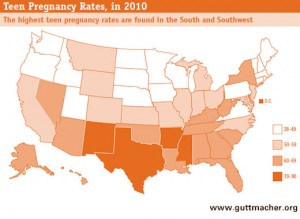Sound the Alarm: Youth Sexual Health Crisis in America
Mar 11th, 2015 | By admin | Category: Youth RightsBy Kimberly Absher, guest youth blogger, www.howmany.org.
After looking at sexual education challenges in South Africa and in the U.K., it seems appropriate to examine our sexual education picture in the United States.Currently there are no national standards for sexual education. Instead, the width and breadth of what students learn is determined on a state by state basis. In states where sexual education is not officially required, school district officials often decide.
According to the National Conference of State Legislatures, 22 states and the District of Columbia require that public schools teach sexuality education. Thirty three states and the District of Columbia require HIV/AIDS information to be taught. In (just) 19 states, the law requires that if sex education is taught then it must be medically, factually or technically accurate, the exact definition of which varies. For the rest, well, we just hope for the best.
Abstinence-only = Tragic reality
Over the course of the George W. Bush administration, taxpayers paid between $80 million and $176 million every year to abstinence education programs. Considering that mind-boggling amount of money, young people should be doing well, right?
Not so much. The United States has the highest rate of teenage pregnancy in the industrialized world, with nearly 1 in 4 females giving birth before turning 20. The fiscal toll of teenage parents on taxpayers is more than $9.4 billion every year.
There should be no denying that young people have sex. In a 2011 Center for Disease Control survey, half of high school students said they had engaged in sex, and 15 percent reported having sex with four or more partners in their lifetime. Among students who had sex in the three months prior to the survey, 60 percent reported condom use and 23 percent reported birth control pill use during their last sexual encounter.
Lack of sexual protection leads to youth being extremely affected by sexually transmitted infections. 15-24 year old Americans make up a quarter of the sexually active population, yet account for half of all new STI’s. Nearly a quarter of new HIV diagnoses are given to people between the ages of 13 to 24. Isn’t that crazy?!
For young people of color, sexual health is even more of an issue, particularly for black and Latino/Hispanic youth, who make up an overwhelming percentage of new HIV cases. In terms of sexual assault, American Indian and Alaskan Native women are 2.5 more likely to be raped than the average American woman, who is still looking at a 1 in 4 chance of sexual violence, and the statistics are 1 in 7 for males. Abstinence-only sexual education seldom covers consent, sexual harassment or abuse.
The Obama administration cut funding to two discretionary abstinence-only programs in 2009, reallocating over $100 million to evidence-based initiatives. A few months later, however, as part of the health care reform, $50 million per year for five years was allotted for Title V abstinence program.
The push for national standards
Advocates from several organizations who work on behalf of youth, disease prevention, and a variety of social issues worked together to establish National Sexuality Education Standards. This document presents compelling reasons to teach comprehensive sexual education, outlines developmentally-appropriate topics, and offers an informative overview of the present youth sexual health landscape. It also presents sexuality as a normal, natural part of life.
Without continuing to push for comprehensive sexual education for every young person, regardless of the state they live in, the health of our youth, and by extension the future of our country, will undoubtedly suffer grave consequences in terms of health, economic stability, intellectual capacity, and public safety.
Though sexuality in the United States may be wrought with taboos and moralistic hang-ups, we need to realize that in pushing a rigid agenda onto young people, whose sexual behavior remains unfettered, we are neglecting to care for them and nurture a society where young people have a right to their bodies, a right to say no, a right to say yes, a right to education, and a right to a future. We can, and should, do better.
Kimberly is a youth guest blogger with the Institute for Population Studies. She is currently a freelance writer on topics relating to health, women’s rights, and social change. You may reach Kimberly at kimberlyabsherwrites@gmail.com.


